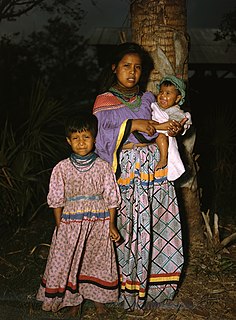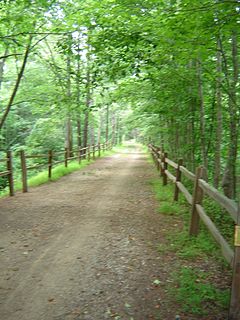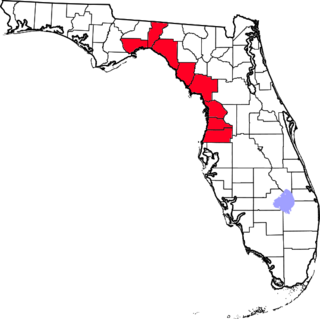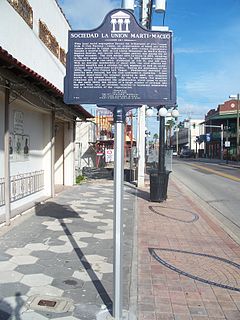Related Research Articles

Davenport is a city in Polk County, Florida, United States. The population was 9,040 at the 2020 census. While the city of Davenport itself is very small, the area north of the city close to Interstate 4 and US 27 is experiencing explosive growth. It is part of the Lakeland–Winter Haven Metropolitan Statistical Area. The current mayor is H.B. "Rob" Robinson, who was appointed in February 2018. Per the City Charter, Mayor Robinson beat former Mayor Darlene Bradley capturing 69.8% of the vote in the municipal election in April 2019.

The Seminole are a Native American people who developed in Florida in the 18th century. Today, they live in Oklahoma and Florida, and comprise three federally recognized tribes: the Seminole Nation of Oklahoma, the Seminole Tribe of Florida, and Miccosukee Tribe of Indians of Florida, as well as independent groups. The Seminole people emerged in a process of ethnogenesis from various Native American groups who settled in Spanish Florida beginning in the early 1700s, most significantly northern Muscogee Creeks from what is now Georgia and Alabama.

Everglades National Park is an American national park that protects the southern twenty percent of the original Everglades in Florida. The park is the largest tropical wilderness in the United States and the largest wilderness of any kind east of the Mississippi River. An average of one million people visit the park each year. Everglades is the third-largest national park in the contiguous United States after Death Valley and Yellowstone. UNESCO declared the Everglades & Dry Tortugas Biosphere Reserve in 1976 and listed the park as a World Heritage Site in 1979, and the Ramsar Convention included the park on its list of Wetlands of International Importance in 1987. Everglades is one of only three locations in the world to appear on all three lists.

The East Coast Greenway is a 3,000-mile (4,800 km) pedestrian and bicycle route between Maine and Florida along the East Coast of the United States. In 2020, the Greenway received over 50 million visits.

The Nature Coast is an informal, unofficial region of the U.S. state of Florida. The broadest definition of the Nature Coast includes the eight counties that abut the Gulf of Mexico along the Big Bend Coast defined by geologists: from west to east, Wakulla, Jefferson, Taylor, Dixie, Levy, Citrus, Hernando, and Pasco counties.

Gainesville-Hawthorne State Trail is a paved rail trail in Florida.

Fort Mose Historic State Park is a former Spanish fort in St. Augustine, Florida. In 1738, the governor of Spanish Florida, Manuel de Montiano, had the fort established it as a free black settlement, the first to be legally sanctioned in what would become the territory of the United States. It was designated a US National Historic Landmark on October 12, 1994.
The history of Tallahassee, Florida, much like the history of Leon County, dates back to the settlement of the Americas. Beginning in the 16th century, the region was colonized by Europeans, becoming part of Spanish Florida. In 1819, the Adams–Onís Treaty ceded Spanish Florida, including modern-day Tallahassee, to the United States. Tallahassee became a city and the state capital of Florida in 1821; the American takeover led to the settlements' rapid expansion as growing numbers of cotton plantations began to spring up nearby, increasing Tallahassees' population significantly.

The Old Dillard High School, also known as the Colored School or Walker Elementary, is a historic school in Fort Lauderdale, Florida. It is located at 1001 Northwest 4th Street. The first school building in Broward County for black students, it was built in 1924 by Cayot & Hart and the architect was John Morris Peterman. On February 20, 1991, it was added to the U.S. National Register of Historic Places. It is the oldest surviving black school in Fort Lauderdale, and is named for black education advocate James H. Dillard. Its first principal, from 1924 until 1937, was Joseph A. Ely. Clarence C. Walker, Sr. served as principal from 1937 until his death in 1942.

Cracker, sometimes white cracker or cracka, is a racial epithet directed towards white people, used especially with regard to poor rural whites in the Southern United States. Although commonly a pejorative, it is also used in a neutral context, particularly in reference to a native of Florida or Georgia.

The Eastern Continental Trail (ECT) is a network of hiking trails in the United States and Canada, reaching from Key West, Florida to Belle Isle, Newfoundland and Labrador.

The St. Augustine movement was a part of the wider Civil Rights Movement in St. Augustine, Florida, in 1963–1964. It was a major event in the city's long history and had a role in the passage of the Civil Rights Act of 1964.
The Florida Keys Overseas Heritage Trail is a 106-mile (171 km) paved rail trail—a multi-use bicycle and pedestrian facility—being constructed between Key Largo and Key West in the Florida Keys. As of January 2022, 90 mi (140 km) of the trail has been constructed.

Florida Heritage Trails is a series of guidebooks available in digital format and as booklets published by the Florida Department of State, Division of Historical Resources. Each guide highlights historical and cultural locations related to a specific time period or group of people, with an emphasis on communities, buildings, museums, archaeology, arts, and festivals. The guides are geared toward tourists, residents, students and scholarly researchers, and all are accessible at no charge via the Florida Department of State web page.

Hopper Academy is a former school for African Americans in Sanford, Florida. It closed in the early 1960s, was used by the school district, and was then abandoned and fell into disrepair. It has been restored and is now a community center. It is on the Florida Black Heritage Trail and listed on the National Register of Historic Places.
The Yemassee Settlement was a residential neighborhood developed in Deland, Florida for African Americans. It was planned during the Progressive Era. The Greater Union Baptist Church was built in the area in 1893. It is a site on Florida's Black Heritage Trail.

La Union Marti-Maceo is a historic social club in Ybor City, Florida established by Afro-Cubans. It opened in 1904 after white and black cigar workers were forced by Florida law to segregate their social clubs during the Jim Crow era. It is a site on Florida's Black Heritage Trail. It is at 1226 East 7th Avenue. The ornate clubhouse was demolished during an urban renewal redevelopment program in the 1960s, and its headquarters was proposed for sale to address financial difficulties in 2018.
References
- ↑ Black Heritage Trail Publication Historical Resources, Florida Department of State
- ↑ Owens, Darryl E. "Ten Stops Along Florida's Black Heritage Trail". Sun-Sentinel . Retrieved January 31, 2018.